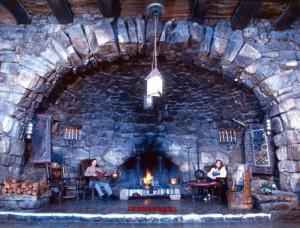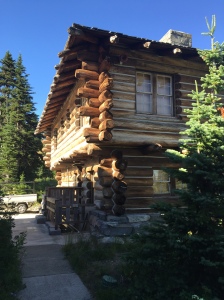When you think of National Parks, you probably think of nature. This is fair, of course: many of the National Parks focus on a natural feature or landscape. The amount of visitors, however, necessitates a built environment within the National Parks. The Park Service has, historically and to the present, taken this task very seriously. Olmsted, the famed landscape architect who designed iconic places like Central Park (and much more–I wrote about him previously, here), designed not only the bridges in Yosemite, but the layout of the roads within the valley.

Despite their diversity in location and landscape, architecture within the National Parks has taken on a particular form. Many of the buildings involve rough-hewn logs and stone, natural elements and inspiration from early settlers and pioneers (and, in some cases, pre-history). This building style has become known as National Park Service rustic, or, colloquially, “Parkitecture.”
One of the most interesting figures in early National Park architecture is Mary Colter (1869-1958), who got to the National Parks through the Fred Harvey Company and the Santa Fe Railway (after graduating with an architectural degree in 1890, her first job was decorating the Indian Building at the Alvarado Hotel in Albuquerque). Colter went on to design a number of stunning stone buildings at the Grand Canyon, including the Hopi House, Hermit’s Rest, and the Watch Tower. (If you are interested and want to learn more, this article about Mary Colter ran a few weeks ago and highly recommend it.)

As you may remember, I recently visited my nearest National Park, Mount Rainier. Sunrise, the northern-most visitor center and parking area, is at a high elevation and offers incredible views of the mountain. The visitor center at Sunrise looks like a fort (see photo, right), taking parkitecture to the next level: not only was it inspired by early settlement architecture of the region, it was actually designed to look like a Hudson Bay Company Fort.
Next time you’re visiting a National Park (don’t forget, August 24 you can get in to all National Parks for free!), when you’re sitting under that rough-hewn-log picnic shelter or stepping into that stone visitor center, think about what may have led the architects’ decisions. Designing a building to be cohesive with a National Park (and not distract too much from the nature!) is no easy feat, but I think the Parkitecture style has done the job well.
Sources:
It is really impossible to sum up such a large subject in a short space! So if you’re interested, I recommend poking around. There’s a lot of good material out there. As I mentioned above, I really can’t recommend this piece on Mary Colter from Curbed enough.
I did some digging through photo galleries on the NPS website to look at parkitecture in parks and examples of Mary Colter buildings (with a story like hers, how could you not want to see every building she designed?). There are a lot of great photos there, including the one, above, of the fireplace at Hermit’s Rest (original photo here). All other photos are my own.
Featured photo (top): I love the northern entryway to Rainier NP. Parkitecture at its finest!


Parkitecture! Love that word. I hope to get to Mount Rainier one day – my brother and his family live in Seattle so it is a possibility! I have only seen it from a distance and it looks stunning.
LikeLike
I definitely recommend it! The views from Sunrise visitor center in particular are amazing!
LikeLiked by 1 person
P.S. Is it just me or does it seem like Olmsted did everything? Maybe because I’m an East Coaster but his name pops up constantly!
LikeLike
Yes, I agree! It really is stunning how much he did. Of course it helps that his son carried on the family business.
LikeLiked by 1 person
Ah – I didn’t know that part! I will need to do some reading 🙂
LikeLike
[…] and curving streets of sidewalks. The architecture at Bryce is emblematic of the developing “Parkitecture” (architecture in National Parks) as well as early twentieth-century ideas about communities […]
LikeLike
[…] Arts and Crafts, “Parkitecture“–if it has large wood beams, count me in! I made a trip back to the Pacific Northwest […]
LikeLike